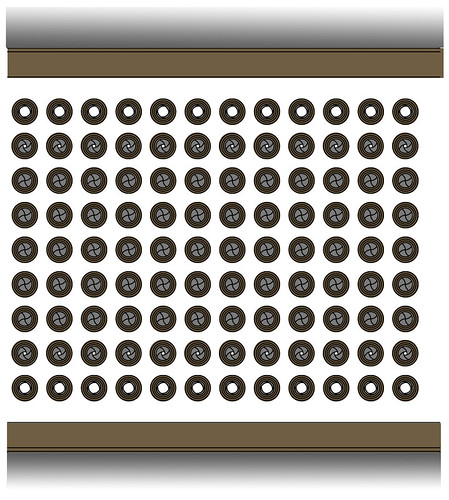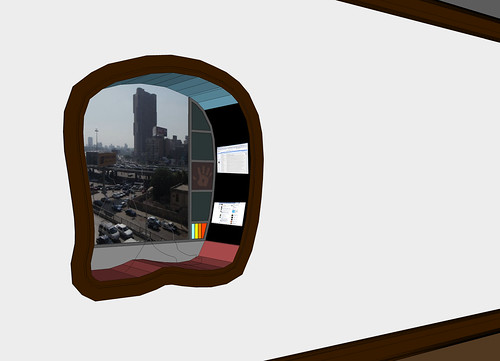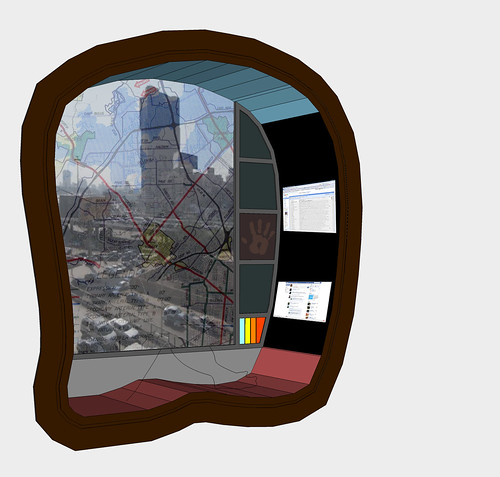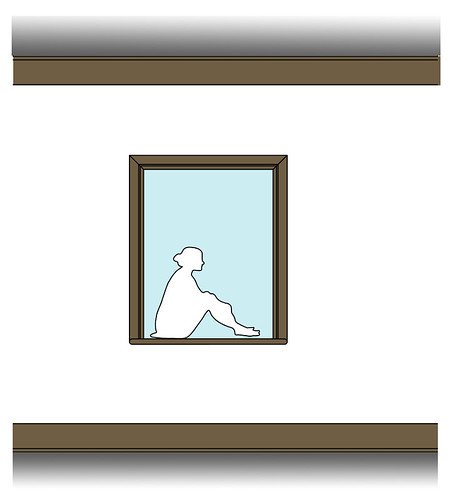The text component of my thesis (when it's written!) will indeed engage with cybernetic organisms both as depicted in fiction and as they are emerging in reality (or should I maybe say we?). Although I am considering diagramming what the 'cyborg subject of the future' might look like as one aspect of the thesis, the design components will not deal with the cyborg subject, per se, at all (by which I am referring to the typically imagined, Terminator-style cyborg).
If, however, we consider all apparatae to be extensions of the human body, and the house to be an apparatus, then the infusion of cybernetics into this 'second skin' does constitute an example of our cyborg-becoming. At any rate, that is what I have chosen to concern myself with. Rather than dealing directly and solely with how the senses of space and place so central to who we are are changing as we incorporate technology into our bodies, I am looking at designing instances in which the architecture itself becomes 'plugged-in'. For example, rather than imagining and describing how we could wear a portable computer which gives us direct retinal access to every document ever published, I am more interested in investigating how we could use a coffee table to interact with that same database. This interest is predicated on two observations: 1st, that our current manner of interacting with computation and information is impoverished and unfortunately biased towards the visual, the most disembodying of the senses; and 2nd that, as Hiroshi Ishii has said, quoted by James Geary, "to actually physically feel something enriches our perception of it and allows us to interact with the environment as we were meant to." By distributing computing throughout the entire house we are no longer 'fixed' to the computer, allowing us to use both our mind and our body simultaneously in navigating a layered world of bits and atoms.
Below, I imagine a window:
 Freed of the traditional structural constraints of lumber or of masonry (for instance by using structural insulated panels or some other distributed structural system) the window could be any shape. What shape should it be? Here, being a window seat, it is intended to fit the human body on the one side, and allow the 'user' to interact with information on the other side. It's also, I noticed, the shape of a 'D'.
Freed of the traditional structural constraints of lumber or of masonry (for instance by using structural insulated panels or some other distributed structural system) the window could be any shape. What shape should it be? Here, being a window seat, it is intended to fit the human body on the one side, and allow the 'user' to interact with information on the other side. It's also, I noticed, the shape of a 'D'. Alternately, the functions of the window (light, communication, ventilation, etc) could be miniaturized and distributed. Above I have attempted to miniaturize and distribute the ventilation function of the window. Ventilation could be controlled very accurately this way, for particular tasks. I have a sketch that shows how this would work on the scale of the house that I will post soon.
Alternately, the functions of the window (light, communication, ventilation, etc) could be miniaturized and distributed. Above I have attempted to miniaturize and distribute the ventilation function of the window. Ventilation could be controlled very accurately this way, for particular tasks. I have a sketch that shows how this would work on the scale of the house that I will post soon. Here is the window seat in perspective. On the one side and on the bottom the unit is lined with foam, while on the other side and the top are two curved lcd screens. The screen opposite the 'user' is to give them access to things like social networking, weather, etc: augmentations of the traditional uses for a window.
Here is the window seat in perspective. On the one side and on the bottom the unit is lined with foam, while on the other side and the top are two curved lcd screens. The screen opposite the 'user' is to give them access to things like social networking, weather, etc: augmentations of the traditional uses for a window. The panel to the right of the glass gives access to various functions. The large black pieces are scroll-surfaces which the 'user' can use by brushing their hand against it: brushing one of them up opens the window; brushing it back down closes the window. The other two black surfaces are for controlling the opacity of the window and the density of the screen. Liquid crystal layered into the glass allows for information to be layered over the world outside. The buttons along the bottom control what information is being displayed - in the image above the weather forecast is being displayed. The reddish panel to the right is a temperature simulator, also for the forecast of weather.
The panel to the right of the glass gives access to various functions. The large black pieces are scroll-surfaces which the 'user' can use by brushing their hand against it: brushing one of them up opens the window; brushing it back down closes the window. The other two black surfaces are for controlling the opacity of the window and the density of the screen. Liquid crystal layered into the glass allows for information to be layered over the world outside. The buttons along the bottom control what information is being displayed - in the image above the weather forecast is being displayed. The reddish panel to the right is a temperature simulator, also for the forecast of weather. Above: traffic conditions for local neighbourhood displayed on the window
Above: traffic conditions for local neighbourhood displayed on the windowAs I have described elsewhere, architecture can be described as the engineering of boundaries between scales of ecological networks. This is fancy-talk for the fact that architecture locates or 'places' us in relation to systems of distribution and production, literal ecological networks (shedding rainwater, keeping the bugs out, growing a garden), and informational networks (a phone number or an ip address for instance). Windows are about permeable, controllable boundaries. Window seats are all about inhabiting these boundaries and this window seat is about inhabiting several boundaries at once.


No comments:
Post a Comment